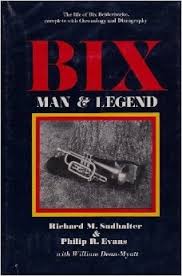|
Bix: Man & Legend
by Richard M. Sudhalter and Phillip H. Evans Dick Sudhalter was a friend of mine. We were teen-aged jazz musicians growing up in Newton, Massachusetts. Dick was a cornetist, and his hero was Bix Beiderbecke. “Someday,” he always told us, “I’m going to write Bix’s biography.” We were skeptical. But 20 years later, good as his word, Dick wrote, with the assistance of one Phillip R. Evans, Bix: Man & Legend. Considered at the time the definitive document on Beiderbecke, it was the first jazz biography ever to have been nominated for a National Book Award, capturing the flavor of Beiderbecke's life and times, while providing dazzling details on every aspect of his music. Music critic Terry Teachout called the book a “landmark of jazz scholarship” and the ”first jazz biography written to the standards of a serious study of a classical composer or other major historical figure.” Bix emerges from these pages as both a musical genius and an American tragedy. Along with Louis Armstrong, he stood at the top of the jazz world in the 1920s, his legend that of a lovable eccentric, an alcoholic, who died at the age of just 29. The Dorothy Baker novel, later a film, Young Man With a Horn, was based at least roughly on Bix’s short, remarkable life. In later years, Louis Armstrong, recalling his contemporary, wrote, “Every musician in the world knew and admired Bix. We all respected him as if he had been a god.” Like all legends, as the years rolled on, the historical facts of Bix’s life grew increasingly vague—until the publication of this meticulously documented tome. Don’t let that word scare you: As scholarly as the book is, it’s a highly readable one that recreates wonderfully the flavor of the times in which the subject lived and played. And written, as it was, by a working cornetist, it offers unique insights into the man’s music. Of course, the fact that Beiderbecke was Sudhalter’s hero, even from boyhood, made the writing of this book a genuine labor of love for the 30-something author, and that shows in the depth and breadth of his chronicle: He relates Bix's story down to the most intimate detail, sometimes offering enlightened speculations that enhance our appreciation of both the subject and his times. For readers for whom Bix Beiderbecke is only an historical jazz name, this is a chance to get some real understanding of the man’s music and the life of one jazz’s most important early influencers. The most avid readers will be pleased to find that the book comes fully loaded with an impeccable discography of Bix’s recordings. Back to Dick Sudhalter. His father was Al Sudhalter, a notable Boston-area alto saxophonist of his time, an adherent to traditional jazz, or what we then called “Dixieland.” Apparently taking his cue from his dad, Dick chose consciously to stick with that early jazz form, which he did, during his entire musical career. (An aside: Dick’s younger sister, Carol, also followed in their dad’s footsteps, but in her case it was in her choice of instrument. Carol, a multi-reeds player, moved from Boston to New York in 1978 to join the first all-female Latin band, Latin Fever, and continues to play in a variety of musical contexts still.) Sticking to “trad” jazz, Dick was a member of the New York Jazz Repertory Company and founder of the New Paul Whiteman Band. In 1983, he co-founded the Classic Jazz Quartet, a traditional jazz ensemble that also included Marty Grosz on guitar, Joe Muranyi on clarinet, and Dick Wellstood on piano. In addition to recording with the Classic Jazz Quartet and the New Paul Whiteman Band, he made several solo albums. But Dick had another career as well: as a journalist. After graduating from Oberlin College, he moved to Europe in 1964, later becoming a United Press International correspondent. In 1968, he covered the Russian invasion of Czechoslovakia from Prague for UPI and was subsequently assigned the role of Manager for Eastern Europe. Back in New York, he wrote a jazz column for the New York Post from 1978 to 1984. Fulfilling his teenage prediction, Sudhalter, of course, did write the biography of Bix Beiderbecke, and a fine job of it he did. As it turned out, Bix: The Man & the Legend was the first of three equally rigorous, enlightening documents. Sudhalter's other books are Lost Chords: White Musicians and Their Contribution to Jazz, 1915-1945 (1999) and Stardust Melody (2002), the first full-length biography of Hoagy Carmichael. (Lost Chords, while highly acclaimed, was not without controversy. But that’s for a another day.) Dick also won a Grammy Award in 1983 for his liner notes for the album Bunny Berigan: Giants of Jazz. Dick Sudhalter’s musical career ended in 2003 when a stroke forced him to quit. He then developed multiple system atrophy, a disease that left him unable to speak and eventually led to his death of pneumonia in 2008. The last time I was with Dick, which was after his stroke but before the terrible disease took over his life, he stunned me with a reassessment of his lifelong determination not to move beyond the traditional jazz which had so defined him. “Maybe that was mistake,” he said. I have to wonder what we might have heard from him. —Terry MacDonald |
Copyright ©2024 Seacoast Jazz Society, All Rights Reserved



